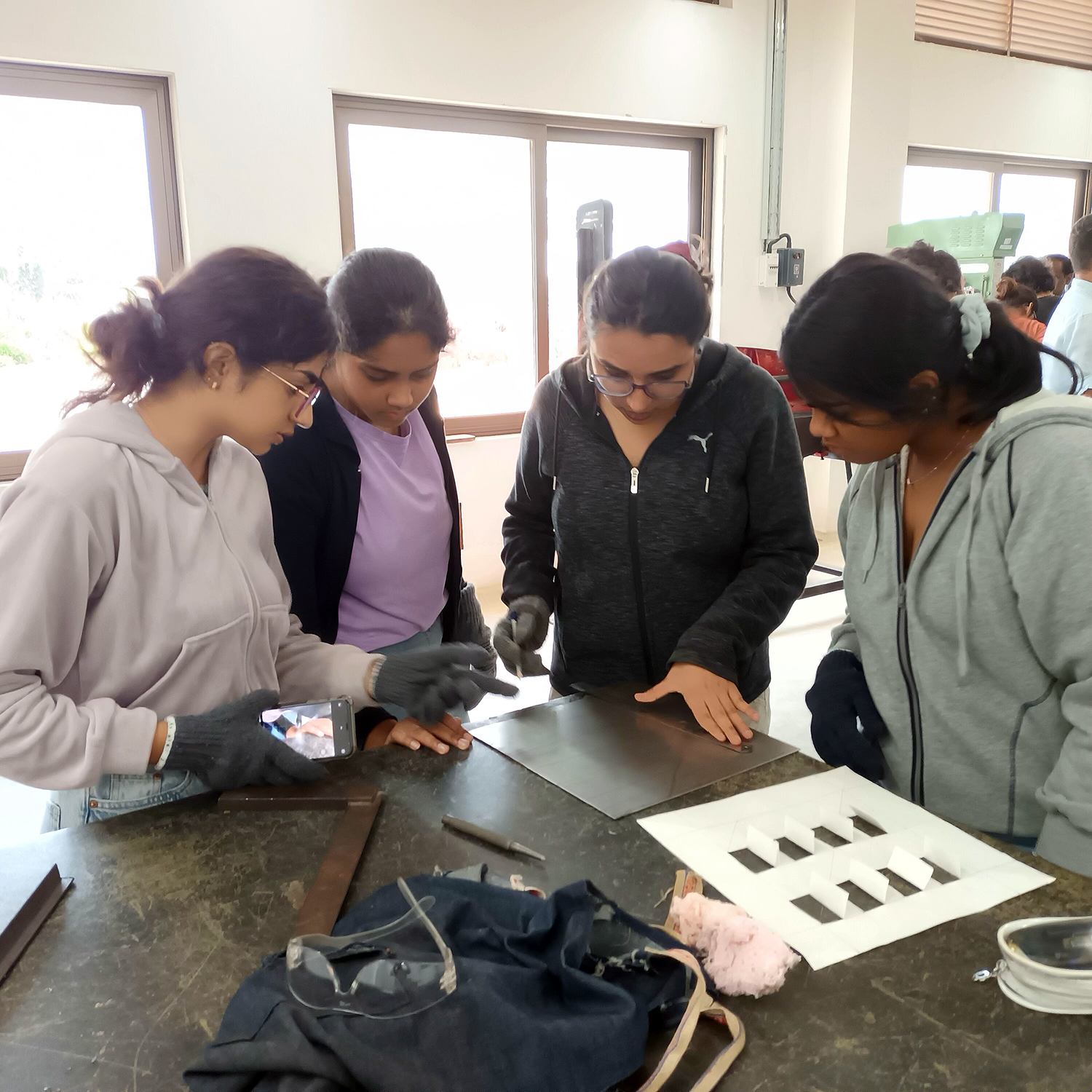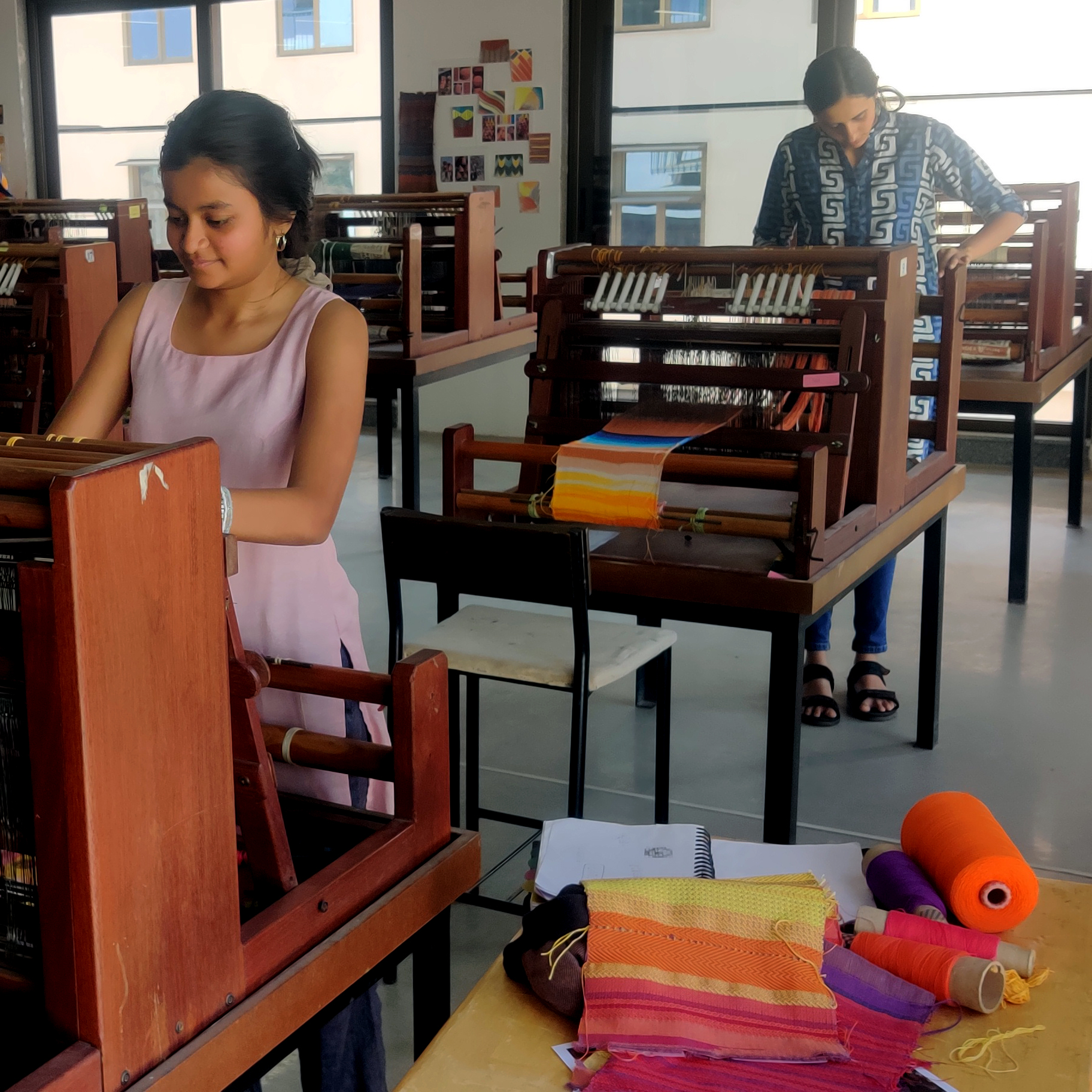Industrial Arts and Design Practices
ABOUT THE PROGRAM
How can we design solutions that benefit people, environments, and creative expression as we shift towards planet-centric design? How can we create sustainable products and systems by mimicking ecologically sound natural ecosystems? How can we adopt traditional practices for a become cyclic and regenerative future? The Industrial Arts and Design Practice course focuses on “making” as a way of thinking, providing hands-on experience to develop an enduring understanding of processes, intuition and sensitivity. Through access to workshops for electronics, laser cutting, 3D printing, weaving, printing, wood, and metal work, you will discover your creative identity and develop as an interdisciplinary artist or designer. Upon completion, potential careers include creative manufacturing, design studios, R&D departments, NGOs, and social enterprises, or further education in related fields.
VISION
How do we set priorities in design? Do we design for people, for the market, for the environment or to express our creative selves? Today as we move to planet-centric design, the question is, how can we shape our practice such that whatever we create is inclusive and caring in nature for a larger, common good? This is a tall ask but as creative practitioners who are trained to ‘make things better’ we often inadvertently do the opposite. Apart from our focus on solving immediate local problems, we also need to consider the impact of our creations on the planet.
In nature, form and structure coexists in the most elegant and harmonious ways. Is it possible for us, as the designers of tangible and intangible man-made objects, to mimic such ecologically prudent ecosystems that are cyclic and regenerative? As responsible designers, we need to begin to use limited resources in frugal and efficient ways and not just design for the sake of doing something ‘new’
Design is about connecting all the dots – how things are made, who makes them, how things are used, who uses them and what happens to these things when they are thrown away. Design is about imagining better futures while taking forward the best of our past. India has a rich history in craft and making and artisans were the first designers. Today we can learn from their frugal practices to design more sustainable products and systems.
The future of ‘how things are made’ is rapidly changing with new technologies and possibilities emerging every day. What does this mean for the designer of the future? There is an increasing move towards engaging directly with materials, tools and emerging technologies like 3D printers is making this think-able and do-able, easier and simpler. Through the course we engage with making at different levels – to acquire skills, to express creative ideas, to have conversations with materials, to think critically and much more. We use making as a way of thinking in the design/art process.
The Industrial Arts and Design Practice course is based on the idea of “making” as a way of thinking. We believe that making is the connection between the head and the heart. Hands-on making leads to an enduring understanding of design and art processes, and allows us to learn with intuition and sensitivity.
As practitioners each of us can find our unique position in the maker space, be it amongst contemporary handcrafted artefacts or adding value to mass-produced objects of everyday use. This course allows you to find out what kind of creative person you are and facilitates your individual development as an artist or designer.
COURSE STRUCTURE
The curriculum comprises of different ways of learning as follows:
- Foundation introduces students to basic principles and tools of Art, Design and Technology as methods, tools and processes. Read more >>
- Disciplinary Studios are learning spaces where students develop core disciplinary capabilities, while navigating a trans-disciplinary environment
- General Studies is a common and compulsory programme of study that integrates Humanities, Sciences, Maths, business and finance. Development and Policy Studies and also offers Languages (Spanish, French and German) Read more >>
- Interim is an immersive introduction to practice in new and emerging areas of art and design and environmental exposure
- Electives are of three kinds – this program allows students to expand their skills, develop the interests as well as provide opportunities for travel exchange
- Internship/Apprenticeship is compulsory work experience done over the summer-break between the 6th and 7th semester
- Project based learning involves the application and synthesis of capabilities acquired. Two projects, pre-thesis and thesis, is culmination of the 4-year undergraduate program, which allows for demonstration of an integration of values, positions, capabilities and practice. Read more >>
LEARNING APPROACH
The learning approach for the Industrial Arts and Design Practice (IADP) course is all about hands-on making and craft as a context for understanding design futures. You will learn by managing materials, exploring and innovating, and making connections between the past, present, and future to discover new potential. This course combines craft and technology to help you synthesize and realize concepts through visualization and translation from a stakeholder’s perspective. You will develop proficiency in working with specific materials and processes and the ability to create frameworks through contemporary ways of perceiving the art and design worlds. The IADP course does not prioritize teaching software skills. However, you will have the opportunity to learn relevant software, such as Adobe Suite and Microsoft Office, on your own. In addition, specialized software like the AutoCAD suite will be introduced in workshops during the course.
CAPABILITIES
Upon successful completion of this course graduates will have developed the following capabilities:
Working with Material
- Acquire a proficiency in working with specific materials and processes, as well as explore a wide range
- Understand and use technologies from the traditional, contemporary to futuristic
- Play and innovate with new materials and technologies to make new connections
- Develop curiosity and respect for material, processes and people
Learning through Making
- Be proficient in using the design process and creative thinking skills and tools- research methods, tools for analysis, ideating, prototyping, testing and validating
- Be proficient in expression through drawing and prototyping
- Explore and experiment in a hands-on manner with materials, processes and techniques in order to develop understanding appropriate and sustainable uses
- Use Making as a conceptual thinking tool for envisioning and translating abstractions into tangible forms
Manage Complexity
- Develop an ability to detail, plan and manage – materials and resources to arrive at a final finished outcome
- Understand the Impact of one’s practice through different lens – Experimentation, Humanity, and Business leading to positioning of one’s practice in a larger framework
- Develop an ability to create frameworks through Making and Reflective response with art, craft and design techniques, processes, and contemporary ways of perceiving art and design worlds.
FAQs
What is Industrial Arts and Design Practice?
Industrial Arts and Design Practice (IADP) is an approach to design solutions that benefit people, environments, and creative expression, and create sustainable products and systems through hands-on making and learning about craft and technology.
Is this course suitable for me?
This course is suitable for individuals who are interested in learning about creating sustainable products and systems to develop their creative identity and skills as interdisciplinary artists or designers and enjoy tangible making to explore the intersection of craft, design, and technology.
What opportunities do I have after completing this course?
The above capability sets equip and prepare the student for a wide range of career opportunities with:
- Creative Manufacturing Sectors – Engaging with artisans and craft units at a small and medium scale and become part of the growing global phenomenon of the Maker movement
- New Product Envisioning and Design studios, R&D departments – Disseminating creative energies as a team player in small & large industries, and multinational corporations
- Grass root development organizations, NGOs & Social Enterprises – Bringing in a breath of fresh air and a new perspective to the conventional through a blend of creative, technical and business acumen
- Start-ups, small and medium enterprises – Propositioning as a contemporary craft practitioner, entrepreneur, design consultant
- Emerging and Trans-disciplinary Domains – Merchandising and Strategic Product Planning in Retail, UI & UX in e-commerce for the transactions of the future




